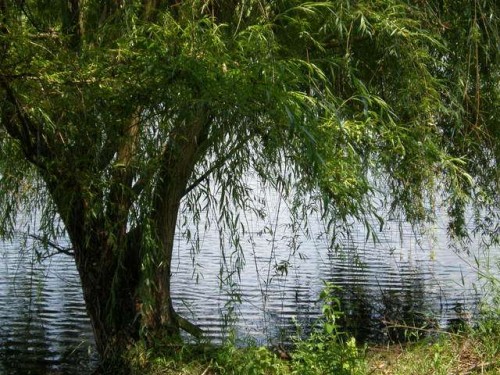|
WILLOW
 It is difficult to be sure of the trees indicated by these names in the Bible. Probably the Hebrew terms for both are somewhat more comprehensive than our English words, and include a variety of stream-loving trees and shrubs. The Hebrew names for the poplars and the willows seem to be derived from whiteness, and many species of both are silvery in appearance, especially when the leaves are blown up by the wind. It is difficult to be sure of the trees indicated by these names in the Bible. Probably the Hebrew terms for both are somewhat more comprehensive than our English words, and include a variety of stream-loving trees and shrubs. The Hebrew names for the poplars and the willows seem to be derived from whiteness, and many species of both are silvery in appearance, especially when the leaves are blown up by the wind.
Willows are fond of the “water courses”; and Lombardy poplars, and also the similar species which is abundant in northern Palestine, are no less so. In moist places, they both grow with great rapidity; and their slender, flexible twigs are everywhere used for basket work. Poplar stems of larger size, from their lightness and straightness, are a favorite wood for rafters. Both trees have their flowers in catkins, the stamens and the pistils on separate trees, and produce a profusion of small, cottony seeds, which blow like down in the wind. The long, slender leaves, which are common among willows, bear a strong resemblance to olive leaves, and some of the large trees are strikingly like olives in general appearance. And, on the other hand, the Lombardy poplars, with every shoot pointing upward as straight as possible, equally resemble the cypress in general appearance. It is also worthy of mention that several of the poplars, by reason of their flattened leaf stems and quivering leaves, are universally taken as symbols of fearfulness and tremulousness.
Swedenborg assigns to both the representation of a low order of intelligence, relating to “natural good” (Arcana Coelestia #4013), and the “lowest goods and truths of the natural man, which belong to the external sensuals” (Apocalypse Explained #458). As the cypress, with its evergreen ascending twigs, corresponds to a knowledge of eternal life in heaven, the poplar—which is so similar in form, but with deciduous fluttering foliage—seems to represent a knowledge of spiritual influences in the natural world—an external sensual knowledge, as of spirits and ghosts, and their influence upon the affairs of men, which, because of its lack of spiritual intelligence, is subject to superstitious fears and fancies.
The willows, in their resemblance to olive trees, represent a similar knowledge of dependence upon the Lord in regard to natural things—such, for instance, as the Israelites had when they heard from their fathers what works were done by the Lord in the days of old, such as is given in the literal story of the Scriptures, and such as is prominent in our national Thanksgivings. Neither tree bears serviceable fruit, but they fill the air with their downy seeds. And so do the simple with their whispers of spirits and ghosts, on the one hand, and, on the other, with sentiments of dependence, which with many take the form of belief in charms and omens, or better, in faithful observance of religious forms. The pliable character of this intelligence, relating to external good from a spiritual or Divine origin, may be the reason why the twigs of the trees so readily permit themselves to be woven into baskets for the reception of material goods. In this shape they represent a state of grateful reception and acknowledgment.
In the Scriptures, willows are associated both with rejoicing and with weeping: with rejoicing in times of prosperity and abundance; with weeping in times of captivity and scarcity. In the celebration of the Feast of Tabernacles, the Israelites were commanded to take, with other emblems, “willows of the brook, and rejoice before Jehovah seven days” (Leviticus 23:40). It is said also in Isaiah: “I will pour My Spirit upon thy seed, and My blessing upon thine offspring; and they shall spring up as among the grass, as willows by the watercourses” (Isaiah 44:4). In both instances they are spoken of as representatives of grateful rejoicing for benefits received. But in the Psalm (137:2), where it is said by the captives in Babylon, “We hanged our harps upon the willows in the midst thereof,” they represent an acknowledgment of natural benefits from the Lord, given now to their enemies, and withheld from themselves. The pendulous boughs of some willows have been taken as forms of grief. And probably they do represent a clinging to the things of earth, and grief for the loss of them.
Author: JOHN WORCESTER 1875
|
|